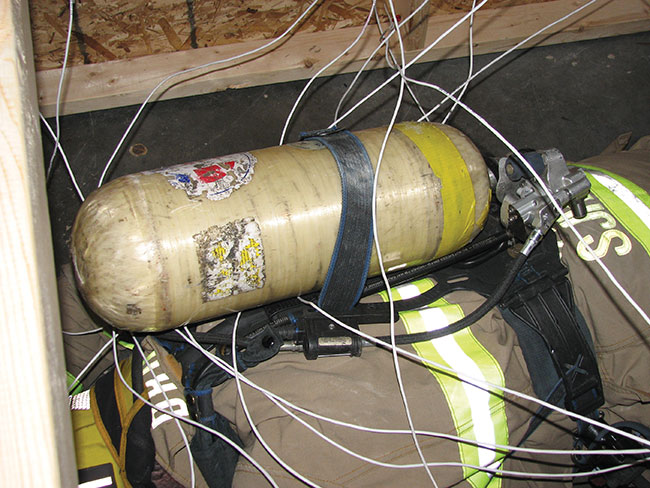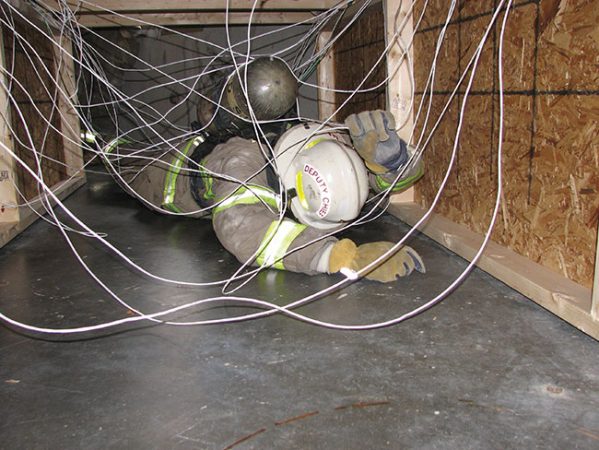
Back to Basics: Firefighter survival
Mark Van
Features Fire Ground Hot Topics editors pick Photo1: It only takes one wire to entangle a firefighter in a potentially deadly entrapment. Photo credit: Mark van der Feyst
Photo1: It only takes one wire to entangle a firefighter in a potentially deadly entrapment. Photo credit: Mark van der Feyst In every residential structure you are going to find entanglement hazards of every type. These include curtains, curtain rods, curtain rod strings, window shades/strings, window blinds/strings, suspended ceilings, electrical wires, television cable, internet wires, HVAC ductwork, dryer vent hose and electrical cords. No matter what kind or type of entanglement hazard it is, it is a hazard and a deadly one at that.
How many wires does it take to entangle a firefighter? It only takes one! (see Photo 1). Only one wire is needed to entangle a firefighter to the point of death. With such a low number needed to create disaster, it is vitally important that firefighters train to deal with entanglements.
There are four possible techniques that can be used for self-rescue from an entanglement:
- The Swim technique
- Partial removal of SCBA
- Complete removal of SCBA
- Wire cutters
The Swim technique: This method of removing wires or entanglement hazards from off the firefighter’s body employs two types of “strokes”, the front stroke and the back stroke. Just like with swimming in the water, the front and back stroke are used to remove the obstruction. The front stroke is where one arm of the firefighter is slid up along their body to pick up or capture the entanglement and then push it forward in front of them. For the back stroke, it is the opposite. The one arm is extended out in front of the firefighter so that they can capture the entanglement and lift it up and over their body as they move forward. See Photo 2 for an illustration.
The one trick to capturing the entanglement hazard is to put tension on the object, such as a wire, to be able to feel the wire. Once the wire is tensioned, the firefighter will have an easier time to grab it and remove it. The one thing that the firefighter does not want to do is to fight the entanglement by trying to force their way out. The firefighter will quickly fatigue themselves to the point of exhaustion. This is when the firefighter will start to give up.
SCBA removal: In this technique, there are two options to exercise or choose from, partial or complete removal. This may be required by the firefighter due to the cause of the entanglement or the fact that the firefighter cannot use the Swim technique to free themselves. Taking the SCBA off the back of the firefighter is a risky option because now the firefighter can lose control of the SCBA and no longer have that piece of PPE. Keeping the SCBA on is the safest and lowest risk to be taken for the firefighter.
When it comes time to remove the SCBA, there are a few key points to keep in mind. Make sure to fully extend all the straps before removing the SCBA. This will allow the firefighter to easily put the SCBA back on as opposed to the straps being retracted and making the donning portion much more difficult to perform. The other key point is to always, always maintain a firm grip on the regulator side of the shoulder strap. This is the firefighter’s lifeline and it they lose this firm grip they will lose the SCBA and the ability to breathe.
A partial removal of the SCBA only requires one shoulder strap to be removed while keeping the other shoulder strap on. This allows the firefighter to position the SCBA to the one side of the firefighter making them a little more streamlined and concealed. The waist strap can be left on the entire time as the SCBA will rotate around the waist easily as long as the strap is fully extended.
For the complete removal of the SCBA, both shoulder straps are coming off the firefighter along with the waist strap. This is where the firefighter has to maintain a firm grip on the regulator shoulder strap of the SCBA. The SCBA will then be pushed in front of the firefighter as they make their way through the entanglement or away from it. Make sure to push the cylinder vale end first as it will provide for more length of low-pressure regulator hose to the face piece. If the top of the cylinder is pushed ahead first, the length of the low-pressure hose will be shortened and will most certainly tug on the firefighter’s mask.

Photo 2: The Swim technique can employ a front or back stroke. Photo credit: Mark van der Feyst
Wire cutters: The last option to look at is to use a pair of wire cutters. This will allow a firefighter to cut their way free from the entanglement. The bigger the wire cutter the better it will be for the firefighter. The firefighter needs to verify what they are cutting before they cut, because it is very easy to grab the low-pressure hose and cut it with a pair of structural fire gloves on. As mentioned in the previous sections, put tension on the entanglement so that you know what to cut. Once confirmed, grab it with your hand, put the wire cutter around the object and cut. Once cut, there should be no more entanglement.
Always keep your wire cutters in a place that can be retrieved easily with a gloved hand. Some firefighters will have two pairs of wire cutters in their gear kept in two various spots for easy access. Make sure to lubricate the cutters every so often to keep them well maintained. Wire cutters do rust and will seize up if not looked after.
The best way to become familiar with all three options is to practice them and vet each one. This will help the firefighter to know which method is best suited for them.
Mark van der Feyst has been in the fire service since 1999 and is currently a firefighter with the FGFD. Mark is an international instructor and he can be contacted at Mark@FireStarTraining.com.
Print this page